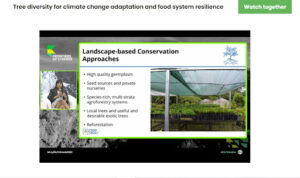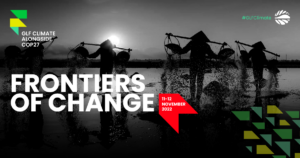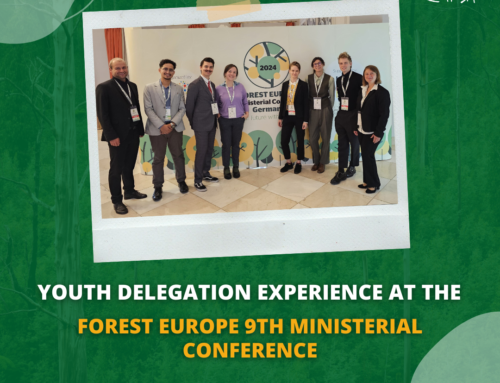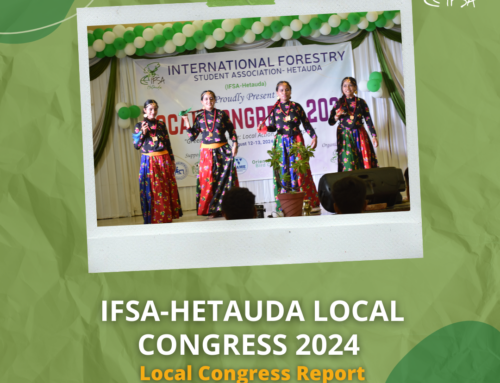IFSA Delegation GLF Climate 2022
What we learned from the conference
Introduction
The Global Landscapes Forum (GLF) is the world’s largest knowledge-led platform on integrated land use. It is scaling up to significantly contribute towards the Sustainable Development Goals (SDGs) and the Paris Agreement led by CIFOR in collaboration with its co-founders, UNEP, the World Bank, and charter members. The forum has five broad themes covering food and livelihoods, rights (gender, tenure, community, and indigenous), landscape restoration, financing sustainable landscapes, and measuring progress.
Hosted on the sidelines of COP27 in Sharm El Sheikh, Egypt, and online, GLF Climate 2022: Frontiers of Change united 7,000 participants from 164 countries and rallied over 27 million people on social media around what humanity can still do to avoid the worsening impacts of the climate crisis.
Featuring 228 leading scientists, activists, Indigenous leaders, financiers, youth and government leaders, and 96 incredible partner organizations, the second edition of GLF Climate called for a just transition to a stewardship economy that puts people and nature first.
Across 43 plenaries, expert sessions, launches, virtual tours, dialogues, networking sessions, and inspirational talks, GLF Climate 2022 explored ways to take control of our fate through collective action, behavior change, and the widespread adoption of nature- and land-based solutions.
Session highlights
Tree diversity for climate change adaptation and food system resilience
Enormous numbers of tree species are essential as they provide various benefits for human–beings, such as food, fibers, nutraceuticals, soil benefits, or pollination. But also, many species face endangered status, which demands conservation efforts. Different conservation strategies can be practiced, namely ex-situ, in-situ, and circa situm. Reforestation and afforestation will help maintain tree diversity. In addition, exotic monocultures can be detrimental to ecosystem services. They are not resilient and provide very limited benefits for biodiversity. Thus, native tree species are encouraged to plant as they are good for ecosystem functioning, biodiversity, and resilience. We should promote growing trees and crops together, as “multipurpose trees can mitigate impacts from extreme calamities for crops (e.g windbreak, cyclone resistance), agroforestry also tackles the climate change impact and sustains the food system for the livelihoods.

TreesAdapt: trees and forests to adapt agriculture, land, and people – CIFOR and ICRAF
Tree commodities and agroforestry systems and their value chains are already impacted by climate change and will be even more strongly affected in the future. Given their permanence, trees are often good markers of following climate impacts on ecosystems. At the same time, forests and trees are key to buffering the impacts of climate change on agriculture and other sectors, including water, infrastructures, cities, and the most vulnerable populations, starting with forest-dependent communities but playing a role in the adaptation of farmers and urban populations, given the effects of forests and trees on local climate and their roles in the water cycle and provision of other ecosystem services. Trees reduce extreme temperatures in all seasons and times of day, reducing the impacts of heatwaves on human health, plant yield, and animal productivity. Forests and trees contribute to water conservation and circulation by facilitating water infiltration in the soil, reducing the intensity of floods, pumping moisture back from the soil during drier seasons, and restoring it through evapotranspiration that can benefit plants locally and regionally. Trees reduce wind and water soil erosion and their consequences on soil fertility, dams, and riverbeds. Tree-based systems and activities also contribute to food security and nutrition by providing food, feed, and livelihood opportunities, particularly in times of crisis. All these contributions are of particular significance for the most vulnerable populations, particularly those exposed to the impacts of climate change in rural and urban areas.
Food and Forest: Accelerating action to reduce scope three emissions.
Our food systems are responsible for a third of all greenhouse gas emissions globally. Each part of a food item’s journey produces green gas emissions from growing to processing to transporting to packaging to consuming and disposing of. Many Food and beverage companies are taking action to reduce these emissions to combat climate change. Scope 1 describes the different kinds of emissions a company creates both in its own operations and in its wider value chain. Scope 2 covers indirect emissions from the energy that the company has purchased. Scope 3 often represents the bulk of a company’s emissions and offers the greatest opportunity to reduce greenhouse gases. In food manufacturing, it accounts for more than 90% of emissions. It is also the hardest to address. Companies can replace their vehicles with electric ones or lower the heating in their buildings, but it’s much more challenging to set sustainable standards for their suppliers. One place to start is to review their supply chains and build a low-carbon strategy at each stage.
How to mitigate environmental risk/impact on food.
Deforestation occurs if palm oil has to be extracted, which leads to scope three emissions. The practice of draining peat soil results in an increase in oxygen in the soil profile, which gives soil microbes the right conditions to break down the peat into carbon dioxide. This process is called peat oxidation, which can create environmental and farmers problems. From an ecological perspective, peatlands are a significant global carbon store. Maintaining peatlands is one of the strategies recommended by the Intergovernmental Panel on Climate Change (IPCC) to reduce climate change’s impacts. On the ground, peat oxidation can lead to an increase in the rate of flooding in the plantation, impacting yields and the ease of using machinery. However, management strategies exist that enable the cultivation of this valuable product while increasing the protection of the soil it grows.
A second effective means of reducing peat oxidation is by ensuring the peat is shaded, particularly while the palms are young and the canopy is open. Ensuring sufficient shade cover can reduce scope three emissions because biochemical reactions speed up at higher temperatures. Cooler soil temperatures slow the rate of oxidation, reducing the carbon emissions produced by the process. Implementing these solutions in oil palm cultivation will reduce the rates of peat oxidation while maintaining the high yield potential of soils.
A major source of food-related emissions comes from beef production, specifically from the agricultural production process (including the digestive process, wastes, and feed production) and from clearing land for new pastures, which releases carbon previously stored in vegetation and soils. Emissions from beef production systems come primarily from enteric methane (“cow burps”), manure management, feed production (whether pasture- or crop-based), and land clearing. There are four main opportunities for beef producers to reduce emissions, which altogether could reduce emissions from ruminant livestock by up to 1.7 billion tonnes of carbon dioxide equivalent per year by 2050:
Firstly, Improve efficiency and productivity. One of the greatest opportunities to reduce emissions from beef production is to improve efficiency. “Improved efficiency” can refer to more efficient land use, reducing pressure to clear more land, fewer greenhouse gas emissions per kilogram of beef produced, and more efficient feed use. To boost efficiency without compromising animal welfare, producers can develop more digestible feeds, improve feeding practices, plant pastures with improved grasses and legumes, breed cattle for higher growth rates, improve veterinary care, and improve grazing management. These types of efficiency improvements have reduced beef production emissions intensity over time. However, absolute emissions — the overall emissions from beef production — have continued to climb. Additionally, productivity gains from efficiency can increase profit, which may lead producers to expand their business in a way that clears more land. Therefore, productivity gains need to be accompanied by local ecosystem protection to avoid a “rebound effect” of additional land clearing.
While efficiency improvements reduce enteric methane emissions per kilogram of beef produced, additional technological interventions could reduce enteric methane emissions. Enteric methane inhibitors are promising options. These include the chemical 3-NOP, as seaweed.
Thirdly Improve manure management. Better management of animal wastes can reduce both methane and nitrous oxide emissions. Examples of improved manure management include more frequent waste removal from the barn and covering the tanks containing semi-solid waste. Using animal wastes as a source of nutrients for crops also reduces the need for applied synthetic nitrogen fertilizers, which avoids the emissions from manufacturing and transporting those fertilizers.
Fourth, Stabilize and sequester carbon in vegetation and soils. It’s widely accepted within the scientific community that increasing soil carbon improves soil health, and practices are commonly referred to as “regenerative.” In places where soil quality is poor, and beef output per hectare is relatively low — which is prevalent in the tropics — practices such as rotational grazing and silvopasture can boost yields of beef per hectare and sequester additional carbon in soils and vegetation.
However, the mitigation potential of carbon sequestration on grazing lands is likely limited. The impacts of improved management practices on soil carbon are reducing emissions from beef purchasing, engaging Suppliers, and improving traceability.
Soy farming is linked to deforestation, biodiversity loss, and other environmentally damaging factors. This finding is used by opponents of plant–based protein, arguing that soy in these products makes them unsustainable and does not play a part in reducing carbon emissions as claimed by many experts and plant–based brands. Soy’s contribution to carbon emissions can be traced to multiple activities, including deforestation, industrial processing, and transportation. The conversion of natural landscapes to cultivate soy, also called ‘land use change,’ is a major reason for increased emissions. Using industrial processing facilities and vehicle fleets to distribute soy globally contributes to soy’s carbon footprint. Soy cultivation is often highly mechanized and requires intensive irrigation since it is also a crop that requires significant amounts of water. The combined effect of such farming methods and natural resource consumption has had a damaging impact on topsoil, disrupting the soil’s natural ability to absorb Carbon Dioxide from the atmosphere, it’s functioning as an ecosystem, and its ability to reabsorb nutrients and water. As with many commercialized crops, pesticides and fertilizers during soy farming also contaminate rivers, lakes, and estuaries, impacting wildlife and posing health risks to rural communities that consume the water. This has the direct impact of displacing wildlife and destroying or polluting their food and habitats. Indirectly, damaging healthy soils has made the area more susceptible to forest fires, further threatening biodiversity.
Tree diversity for climate change adaptation and food systems
Landscape-based conservation approaches require high-quality germplasm, a good seed source and nursery, propagation of local trees and useful and desirable exotic trees, and active reforestation. The world is endowed with so much diversity. To maximize the use of global tree diversity, we need to recognize, identify, protect, and conserve them for sustainable use. Multipurpose trees are crucial for providing food in various areas of the world, and maintaining their diversity is crucial in ensuring sustainable access to their benefits. Tree diversity is also crucial in the fight against climate change. Some species can withstand extreme weather conditions. Terminalia richi can withstand cyclones; Pandonus tectorius keeps fruiting and provides food during prolonged droughts. Some trees can tolerate saline salts, long droughts, and extreme temperatures. These trees exist in different areas in the world and need to be conserved and utilized in forest restorations in these periods of climate change.
Forest conservation and forest restoration face many wicked challenges, such as inadequate skilled manpower, low-quality planting materials, inadequate seed, and gene banks in various locations worldwide, and inadequate funding for restoration projects. Despite the availability of inputs such as tree diversity and agroforestry tree gene banks, there is a need for capacity building for efficient tree planting and forest restoration and also a need for funding even though there are few donors already. It is also crucial to have quality planting material to ensure the sustainability of our tree planting and forest restoration programmes. Long-term donors are encouraged to invest in tree gene banks because investment in tree materials is profitable with a cost-benefit of up to 7 and a net benefit of more than USD 500 million.
Loss and Damage: Funding Climate Justice
The session was focused on loss and damage funding. Ayisha Siddiqa discussed loss and damage and explained that financing mechanisms should be implemented to handle loss and damage financing. She explained that it should be legally binding to make money available for financing and ensure that money reaches those who need it. Rahima Paulette also discussed how climate finance should reach people at the grassroots level, explaining that organizations should work directly with stakeholders and create social media awareness for climate events. She said if poor people have no choice, they will use coal for industrialization and contribute even more to climate change. Emily Boho explained that the developed countries cause climate change, and the most vulnerable are the developing and underdeveloped countries. She also explained that developed countries must provide climate finance to these vulnerable countries.
Key messages
We know how to grow at least 18 000 tree species and solve the problems we are encountering. The point is how to translate our knowledge into good practice. We need to diversify our tree-planting portfolios.
Planting a tree and protecting a forest are promoted as adaptation measures because
of their ecosystem services that contribute to adaptation now and -given the future lifespan of trees and forests. To avoid maladaptation and maximize benefits, it must be the right tree, in the right place, and for the right purpose. And it has to be done well.
“We can’t go to mitigation and leave behind these vulnerable areas which have least contributed.”
Emily Boho on why loss and damage are an issue.
The focus shouldn’t be on higher-level involvement. Everybody can be involved by volunteering and planting a few indigenous tree species or useful exotic tree species in their gardens.
The delegates learned that mitigation is not enough. Loss and Damage have to be managed before climate change can be mitigated.
Reference
https://conference.globallandscapesforum.org/climate-2022/
Compiled by: Elivis Omoit, Head of Sub-Commission CIFOR/YIL
Contributors to the article: Tam Do, Ayinde Busayo Toyosi, Olanrewaju Rukayat, Mustapha Maryam.




